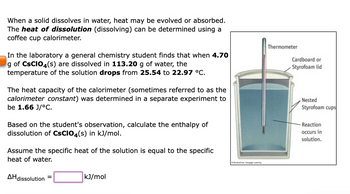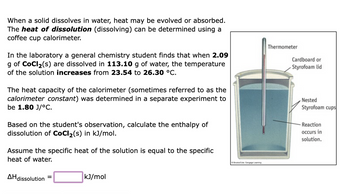
Chemistry
10th Edition
ISBN: 9781305957404
Author: Steven S. Zumdahl, Susan A. Zumdahl, Donald J. DeCoste
Publisher: Cengage Learning
expand_more
expand_more
format_list_bulleted
Question

Transcribed Image Text:When a solid dissolves in water, heat may be evolved or absorbed.
The heat of dissolution (dissolving) can be determined using a
coffee cup calorimeter.
In the laboratory a general chemistry student finds that when 4.70
g of CSCIO4(s) are dissolved in 113.20 g of water, the
temperature of the solution drops from 25.54 to 22.97 °C.
The heat capacity of the calorimeter (sometimes referred to as the
calorimeter constant) was determined in a separate experiment to
be 1.66 J/°C.
Based on the student's observation, calculate the enthalpy of
dissolution of CSCIO4(s) in kJ/mol.
Assume the specific heat of the solution is equal to the specific
heat of water.
AH dissolution
kJ/mol
BrookCo, Cengage Leaming
Thermometer
Cardboard or
Styrofoam lid
Nested
Styrofoam cups
- Reaction
occurs in
solution.

Transcribed Image Text:When a solid dissolves in water, heat may be evolved or absorbed.
The heat of dissolution (dissolving) can be determined using a
coffee cup calorimeter.
In the laboratory a general chemistry student finds that when 2.09
g of CoCl₂(s) are dissolved in 113.10 g of water, the temperature
of the solution increases from 23.54 to 26.30 °C.
The heat capacity of the calorimeter (sometimes referred to as the
calorimeter constant) was determined in a separate experiment to
be 1.80 J/°C.
Based on the student's observation, calculate the enthalpy of
dissolution of CoCl₂(s) in kJ/mol.
Assume the specific heat of the solution is equal to the specific
heat of water.
AH dissolution
kJ/mol
BrookCo, Cengage Leaming
Thermometer
Cardboard or
Styrofoam lid
Nested
Styrofoam cups
- Reaction
occurs in
solution.
Expert Solution
This question has been solved!
Explore an expertly crafted, step-by-step solution for a thorough understanding of key concepts.
Step by stepSolved in 4 steps with 3 images

Knowledge Booster
Learn more about
Need a deep-dive on the concept behind this application? Look no further. Learn more about this topic, chemistry and related others by exploring similar questions and additional content below.Similar questions
- When 5.325 g KCL dissolves in 100.0ml of water the temperature decreases from 24.1 c to 21.2 c. Calculate the change in enthalpy per mole of KCL. Determine if the process is endothermic or exothermic.arrow_forwardWhen two solutions are combined in a test tube, they quickly react and the test tube containing the reaction becomes instantly hot to the touch. Is this reaction exothermic or endothermic? Briefly explain how you know.arrow_forwardThe heat evolved when aqueous solutions of NaOH and HCI are mixed is determined using a coffee cup calorimeter. The heat of reaction determined in this way is a measure of for the reaction. O a. AP b. ΔΗ C. PAV d. ΔΕ O e. -PAVarrow_forward
- Explain the concept of specific heat and how the specific heat of water enables the human body to remain at a relatively constant temperature. Use details to support your answer.arrow_forward6) A block of rhenium metal (specific heat =0.0329 cal/ gC) is heated to 88.2C and then dropped into 100.0 g of water initially at 26.4 C. The final temperature of the mixture is 32.4C. What was the mass of the block of rhenium?arrow_forwardA 5.43 g sample of an unknown salt (MM = 116.82 g/mol) is dissolved in 150.00 g water in a coffee cup calorimeter. Before placing the sample in the water, the temperature of the salt and water is 23.72°C. After the salt has completely dissolved, the temperature of the solution is 28.54°C. If -3.13 x 10 J of heat was lost during the dissolution reaction of 0.0465 moles of the unknown salt, what is the enthalpy change (in kJ/mol of salt) for the dissolution reaction? Type here to searcharrow_forward
- When substances are dissolved in water, they can absorb or release heat. Describe how you would use a calorimeter to determine the amount of heat required or released to when 10 grams of sugar is dissolved in 100 grams of water. Describe how you would calculate the heat absorbed or released by the sugar with the data you collect. (Do no perform any calculations.)arrow_forward1. A thermometer placed in a solution undergoing a chemical reaction indicates an increase in temperature as the reaction proceeds. Is this reaction endothermic or exothermic? Describe if heat energy is lost or gained from the reaction (the system) to the surroundings. What is the sign of the enthalpy change (AH) of this reaction? 2. A student performs a reaction and determines the enthalpy change (AH) to be 31.4 kJ. Will the temperature of the surrounding solution increase or decrease as a result of this chemical process? 3. If you hold 3 grams of ice in your hand at room temperature, your hand will become cold. a) Is the reaction H,O(s) – H,O(1) endothermic or exothermic? b) In which direction does heat flow?arrow_forwardIn order to break water into hydrogen and oxygen, water is heated to more than 500°C. Which kind of reaction is this and why? It is exothermic because heat needs to be released by the reactants to form the products. It is endothermic because heat needs to be released by the reactants to form the products It is exothermic because heat needs to be absorbed by the reactants to form the products. It is endothermic because heat needs to be absorbed by the reactants to form the products.arrow_forward
arrow_back_ios
arrow_forward_ios
Recommended textbooks for you
 ChemistryChemistryISBN:9781305957404Author:Steven S. Zumdahl, Susan A. Zumdahl, Donald J. DeCostePublisher:Cengage Learning
ChemistryChemistryISBN:9781305957404Author:Steven S. Zumdahl, Susan A. Zumdahl, Donald J. DeCostePublisher:Cengage Learning ChemistryChemistryISBN:9781259911156Author:Raymond Chang Dr., Jason Overby ProfessorPublisher:McGraw-Hill Education
ChemistryChemistryISBN:9781259911156Author:Raymond Chang Dr., Jason Overby ProfessorPublisher:McGraw-Hill Education Principles of Instrumental AnalysisChemistryISBN:9781305577213Author:Douglas A. Skoog, F. James Holler, Stanley R. CrouchPublisher:Cengage Learning
Principles of Instrumental AnalysisChemistryISBN:9781305577213Author:Douglas A. Skoog, F. James Holler, Stanley R. CrouchPublisher:Cengage Learning Organic ChemistryChemistryISBN:9780078021558Author:Janice Gorzynski Smith Dr.Publisher:McGraw-Hill Education
Organic ChemistryChemistryISBN:9780078021558Author:Janice Gorzynski Smith Dr.Publisher:McGraw-Hill Education Chemistry: Principles and ReactionsChemistryISBN:9781305079373Author:William L. Masterton, Cecile N. HurleyPublisher:Cengage Learning
Chemistry: Principles and ReactionsChemistryISBN:9781305079373Author:William L. Masterton, Cecile N. HurleyPublisher:Cengage Learning Elementary Principles of Chemical Processes, Bind...ChemistryISBN:9781118431221Author:Richard M. Felder, Ronald W. Rousseau, Lisa G. BullardPublisher:WILEY
Elementary Principles of Chemical Processes, Bind...ChemistryISBN:9781118431221Author:Richard M. Felder, Ronald W. Rousseau, Lisa G. BullardPublisher:WILEY

Chemistry
Chemistry
ISBN:9781305957404
Author:Steven S. Zumdahl, Susan A. Zumdahl, Donald J. DeCoste
Publisher:Cengage Learning

Chemistry
Chemistry
ISBN:9781259911156
Author:Raymond Chang Dr., Jason Overby Professor
Publisher:McGraw-Hill Education

Principles of Instrumental Analysis
Chemistry
ISBN:9781305577213
Author:Douglas A. Skoog, F. James Holler, Stanley R. Crouch
Publisher:Cengage Learning

Organic Chemistry
Chemistry
ISBN:9780078021558
Author:Janice Gorzynski Smith Dr.
Publisher:McGraw-Hill Education

Chemistry: Principles and Reactions
Chemistry
ISBN:9781305079373
Author:William L. Masterton, Cecile N. Hurley
Publisher:Cengage Learning

Elementary Principles of Chemical Processes, Bind...
Chemistry
ISBN:9781118431221
Author:Richard M. Felder, Ronald W. Rousseau, Lisa G. Bullard
Publisher:WILEY